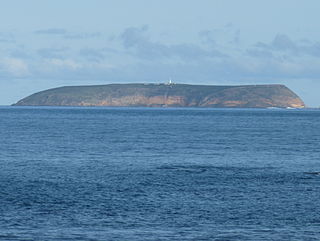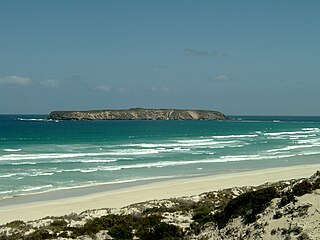
Flinders Chase National Park is a protected area in the Australian state of South Australia located at the west end of Kangaroo Island about 177 kilometres west-south west of the state capital of Adelaide and 110 kilometres west of the municipal seat of Kingscote. It is a sanctuary for endangered species and home to a few geological phenomena. It was the second national park to be declared in South Australia.

Seal Bay Conservation Park is a protected area located on the south coast of Kangaroo Island in the Australian state of South Australia. It is the home of the third largest Australian sea lion colony in Australia.

The Investigator Group is an archipelago in South Australia that consists of Flinders Island and five island groups located off the western coast of the Eyre Peninsula. It is named after HMS Investigator by her commander, Matthew Flinders when he explored the area in 1802. The Group lies within the Great Australian Bight. All the islands except Flinders Island, and a part of Pearson Island, are within the Investigator Group Wilderness Protection Area and the Waldegrave Islands Conservation Park.

Nuyts Archipelago Conservation Park is a protected area in the Australian state of South Australia located on Eyre Island and St Peter Island in the Nuyts Archipelago located off the west coast of Eyre Peninsula about 10 kilometres south and 25 kilometres south-east respectively of Ceduna.

.

The Pages is an island group in the Australian state of South Australia consisting of two small islands and a reef located in Backstairs Passage, a strait separating Kangaroo Island and the Fleurieu Peninsula. The island group has been located with the protected area known as The Pages Conservation Park since 1972.

The Pages Conservation Park is a protected area in the Australian state of South Australia which is associated with the island group known as The Pages located in Backstairs Passage about 25 kilometres south-east of Cape Jervis and about 98 kilometres south south-west of the state capital of Adelaide.

Althorpe Islands Conservation Park is a protected area in the Australian state of South Australia occupying the Althorpe Island, Haystack Island and Seal Island in Investigator Strait near the town of Stenhouse Bay.

The Whidbey Isles Conservation Park is a protected area in the Australian state of South Australia which consists of seven islands located about 15 kilometres (9.3 mi) west-southwest of Coffin Bay on the lower Eyre Peninsula.

Investigator Group Wilderness Protection Area is a protected area in South Australia, located in the Investigator Group of islands off the west coast of Eyre Peninsula, between 25 kilometres and 70 kilometres south-west of Elliston.

Waldegrave Islands Conservation Park is a protected area located on the following islands within the Investigator Group in South Australia: the Waldegrave Island, Little Waldegrave Island and the Watchers.

Baird Bay Islands Conservation Park is a protected area in the Australian state of South Australia associated with two islands located in Baird Bay on the west coast of Eyre Peninsula respectively about 32 kilometres and 45 kilometres west south-west of Streaky Bay.

Olive Island Conservation Park is a protected area in the Australian state of South Australia associated with Olive Island off the west coast of Eyre Peninsula and which is located about 25 kilometres west-northwest of the town of Streaky Bay.

Tumby Island Conservation Park is a protected area in the Australian state of South Australia associated with Tumby Island in Spencer Gulf and located about 5 kilometres southeast of the town of Tumby Bay.

Mount Dutton Bay Conservation Park is a protected area in the Australian state of South Australia located on the west coast of Eyre Peninsula on islands located on waters in the sector between the north west to the east of the town of Coffin Bay.

Topgallant Islands is an island group in the Australian state of South Australia located in the Investigator Group about 22 kilometres south west of Cape Finniss on the west coast of Eyre Peninsula. The group was discovered and named by Matthew Flinders on 13 February 1802. The island group has enjoyed protected area status since the 1960s and since 2011, it has been part of the Investigator Group Wilderness Protection Area.

Waldegrave Islands is an island group in the Australian state of South Australia located in the Investigator Group about 2.5 kilometres northwest by west of Cape Finniss on the west coast of Eyre Peninsula. The group consists of Waldegrave Island, Little Waldegrave Island and according to some sources, a pair of rocks known as the Watchers. The group is notable as a breeding site for Australian sea lions and Cape Barren geese. The group has enjoyed protected area status since the 1960s and as of 1972 has been part of the Waldegrave Islands Conservation Park.

.

Investigator Marine Park is a marine protected area in the Australian state of South Australia located in the state's coastal waters in its west adjoining the west coast of Eyre Peninsula and islands in the Investigator Group respectively to the south-east and south-west of the town of Elliston.

Maize Island Lagoon Conservation Park is a protected area in the Australian state of South Australia located in the locality of Holder about 155 kilometres (96 mi) north-east of the state capital of Adelaide and about 2 kilometres (1.2 mi) east of the Waikerie.









